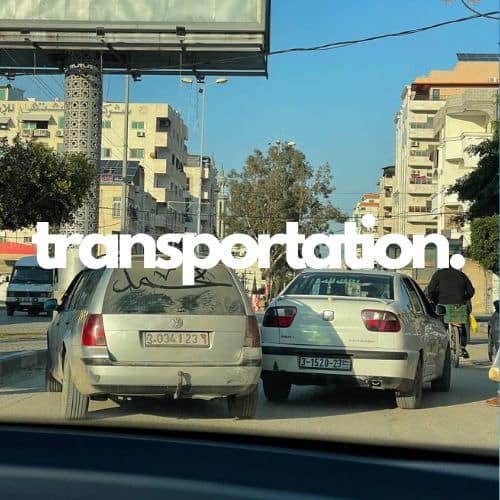Gazan streets are seemingly also overpopulated, as they are, in normal times, crowded with vehicles, tuktuks, different animals, and pedestrians of all ages.
Traveling within the Gaza Strip is truly an experience. The noises, scents, and sights are all distinct and the experience generally chaotic, even for natives who know their way around. While some may be surprised by the fact that Gazans do not wear seatbelts and can fit 10+ people into one sedan, these are simply realities of the Gazan transportation culture that has developed as a result of Gaza’s overpopulation among other things. On top of that, it’s quite fun—to fit an entire family or classroom in one vehicle and to drive among camels and herds of sheep. And, considering what life is like for Gazans, the levity is welcomed with open arms (although that is not to say that Gazans do not care for road safety as many advocate for such).

If we are to speak of transportation, we can say that there is also an overpopulation of cars in the Gaza Strip which are, of course, constantly releasing emissions.
Most Gazans cannot afford personal vehicles so taxis are the most common mode of transportation. Hailing a cab in Gaza is quite the experience and vastly different from what you usually see in your favorite blockbusters set in New York City. In Gaza, whenever one walks down the street, a constant barrage of horns sounding and beeps can be heard. If a car honks, one can either choose to turn and tell the driver their destination or dismiss them with a flick of the hand to indicate that they should move on. Unless one is to call a personal taxi with a service, getting a ride can take anywhere from seconds to over 10 minutes. If one’s destination is a popular area, they can usually find a ride quite quickly. However, if the place is less popular or generally out of the way, one can find themselves standing in the sweltering sun or pouring rain.
Schools and universities tend to have buses or vans that resemble old Volkswagen models as transportation for students. For school-aged children, it is common for over a dozen of them to cram in to one van. Seatbelts are practically never used, even when a vehicle is not overcrowded.
Gaza’s streets are filled with cars, buses, trucks, and many other types of vehicles. A “tuktuk,” or auto rickshaw, is another common mode of transportation, as are donkey-drawn carts, horses and horse-drawn carts, and motorcycles. Camels are not as common as donkeys, mules, and horses but can still be seen on Gazan streets and also on Gaza’s famous seashore.
The busiest traffic times daily were around 12 PM, as this is the transitional hour for schools, when sabahi or morning students are leaving and masa’i or afternoon students are on their way to school. During this time, it seems as though every school-aged student in Gaza is out and on the streets. Street vendors take advantage of these crowds by selling barad, a popular local slushy, Indomie noodles, jellies, and cups of corn. Such treats would all be sold in front of school gates and roads surrounding schools would be nearly impossible to drive through with the hundreds or thousands of students flooding the streets. Attempting to do so would not only pose a challenge but also serve as a source of stress for drivers as the schoolchildren had unsafe antics including playing around and jump over the cars whose drivers dared to enter the infamously overcrowded streets.
Another common cause of traffic were wedding processions. In Gaza, there is a wedding tradition of leading a train of cars, even motorcycles, to a couple’s wedding hall. A truck filled with men playing music from speakers and instruments would lead the train. These car trains were not an uncommon sight and their music was not an unfamiliar sound, especially nearing sundown and during weekends, school breaks, and the summer. The trains tend to start at the groom’s home and drive towards the bride’s home to pick her up. Whenever the train would pass a family or friend’s home, those individuals would also get in their respective decorated car or rental to join the exciting drive towards the wedding hall. It was never uncommon for these car trains to make an impromptu stop in the middle of the road to dance and celebrate in the street, especially the popular Harun Al-Rasheed or Beach Street.
